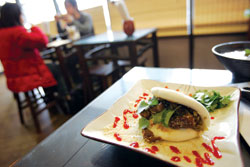If you really want to, you can order up a three-course meal at Facing East,a new Taiwanese restaurant in downtown Bellevue. But that’s not what the legions of foodies who are squeezing onto benches and juggling soup bowls at this small, chic strip-mall restaurant have come for. They’re here to graze—with variety as their guiding principle—on thick soups, small plates of vegetables, and pancakes.
No, not the kind with syrup. The “sweet potato flour pancake with shrimp, egg, and veggies” is a plate-sized omelette swirled together with a transparent, gelatinous batter (that would be the sweet-potato flour part) in the pan. As the pancake bubbles and sets, lettuce leaves and small shrimp are pressed into the top and a rich brown sauce is ladled on. The chewy, eggy pancake is something you finish before realizing how much you enjoyed it.
The menu at this two-month-old cafe is not built on the model of other Taiwanese restaurants in the area, like Rocking Wok or Chiang’s Gourmet, with full dinner menus bulked out with Chinese-American standards. “I’m trying to re-create here most things that people eat in Taiwan,” says owner Yu-ling Wong. “A lot of food vendors in the street sell this food, but they sell just one particular dish.” So Wong stocked the menu with her favorite dishes, compiling an eclectic list of specialties that is attracting hungry Taiwanese Americans in droves.
Taiwanese food is generally considered a Chinese regional cuisine, influenced by not only the indigenous peoples who settled the land but later waves of immigration from the mainland, the last of which crested during the Communist Revolution. The Japanese also occupied the island for the first half of the 20th century, contributing a thing or two to the food.
Facing East’s “appetizers” are common street foods, like the pancakes or a jiggly bun made out of the same mochilike flour and stuffed with braised pork, black mushrooms, and bamboo shoots. The pork “burger” is a puffy steamed bun that looks like a stretched-out marshmallow wrapped around braised pork belly and caramelized onions, with cilantro sprigs and a blend of ground peanuts and granulated sugar sprinkled over top. It’s a strange combination—probably as odd as corn-syrup-sweetened tomato puree slathered over fried potatoes—but one I could see getting a habit for. Our waiter seemed surprised that we only wanted two burgers to split among a party of four.
No American restaurant calling itself Taiwanese could dare omit serving what Facing East calls “soy-flavored chicken with basil,” whose more common name in Chinese and English is “three-cup chicken.” The name comes from the traditional recipe: one cup soy sauce, one cup sesame oil, one cup sweet rice wine. But after the cooks have braised the sauce down to a syrup, that’s not what makes the dish so aromatic. It’s the caramelized garlic cloves and shards of fresh ginger in there, and the fresh Thai basil leaves tossed in at the very end. Another one of the kitchen’s most flavorful dishes is also its humblest: The spiced pork stew over rice, a bowl of rice with a spoonful of meat on top, is meant to accompany the other dishes. But the stew, its ground pork simmered forever, is wonderful in itself.
Many of the small plates that seem most like entrées are worth ordering, with clean, light flavors, glossy with a little oil instead of starch-glooped sauces. Sliced lamb arrived in a barbecue sauce that was neither sweet nor sticky, almost more like teriyaki, with greens and lamb shaved so fine that it crumpled into tullelike shapes and was delectably soft. The “cabbage stir-fried with bacon” was exactly, and perfectly, that. The bacon was unsmoked, so the smokiness in the dish was the kind that a hot, well-seasoned pan imparts.
When the cooks’ minimalist, Michael Graves–esque style works, everything tastes fresh and bright; and when it doesn’t, the food comes off one-dimensional. The stir-fried chow mein with pork and shell-on shrimp was nothing special, and neither was a plate of seasonal vegetables (ingredients: blanched cabbage). The Tainan rolls, free-form shrimp egg rolls, weren’t so tasty as we expected, considering they were deep-fried.
The crowds who’ve discovered Facing East prevented us from trying most of the pottages, which make up a big chunk of the menu. Squid pottage, pork pottage, stuffed fish paste in soup: all out. “You need to come back earlier!” scolded our server. “We’re a small restaurant, so we sell out of things!” Pottage is a style of soup heavily thickened with corn starch. The sole version I tasted, a viscous broth with five-spice-flavored pork meatballs and egg noodles, was beyond flavorless. When I called the restaurant afterward, Wong described her time-intensive process of making the squid pottage. It got me hankering to head east again to give pottage a second chance.






